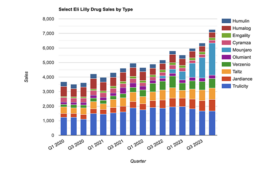
A new class of type 2 diabetes drugs may increase the risk of a rare but serious complication known as diabetic ketoacidosis, according to a study published June 8 in the New England Journal of Medicine.
Investigators from Brigham and Women’s Hospital found that patients are twice as likely to experience diabetic ketoacidosis if taking sodium-glucose cotransporter-2 (SGLT2) inhibitors compared to another class of diabetes drugs.
SGLT2s include canagliflozin, dapagliflozin, and empagliflozin and are approved for use with diet and exercise to lower blood sugar in adults with the disease.
The researchers stress that the condition, while serious, is extremely rare. Only about one in every 1,000 patients taking an SGLT2 inhibitor will experience this complication.
While cases of hospitalization are infrequent, it was one such case that inspired the study. Michael Fralick, MD, FRCPC, of the BWH Division of Pharmacoepidemiology and Pharmacoeconomics, began exploring the association between SGLT2 inhibitors and diabetic ketoacidosis after one of his patients taking SGLT2s arrived at an emergency room with symptoms of the complication.
Using data available through one of the research platforms at Brigham and Women’s Hospital (Aetion Evidence Platform) Fralick’s team compared outcomes of 40,000 patients taking SGLT2 inhibitors to patients taking a DPP4 inhibitor. DPP4 inhibitors were chosen as the comparator medication because they are similarly used as a second-line treatment for diabetes but have no known association with diabetic ketoacidosis.
After 180 days, 55 patients taking an SGLT2 inhibitor had experienced diabetic ketoacidosis compared to 26 patients taking a DPP4 inhibitor.
Fralick emphasizes that even though diabetic ketoacidosis is uncommon, physicians need to be vigilant for signs and symptoms among type 2 diabetes patients. Symptoms include excessive thirst, frequent urination, nausea and vomiting, abdominal pain, fatigue, shortness of breath and fruity-smelling breath.
“My best research projects come from my patients—their experiences drive the questions I investigate,” Fralick said. “This is a side effect that’s usually seen in patients with type 1 diabetes mellitus—not type 2—so doctors are not ‘on the lookout’ for it. That means that the risk of this side effect might actually be even higher than what we found due to misdiagnosis/under recording.”
Reported cases of diabetic ketoacidosis among people with type 2 diabetes taking SGLT2 inhibitors prompted the U.S. Food & Drug Administration to issue a warning in 2015 about the class of drugs.
Filed Under: Drug Discovery




